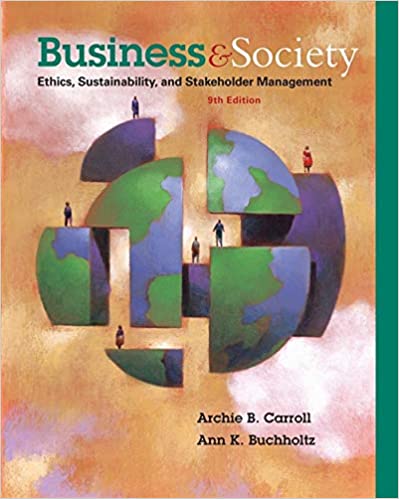
Business and Society 9th Edition by Archie Carroll,Ann Buchholtz
Edition 9ISBN: 978-1285734293
Business and Society 9th Edition by Archie Carroll,Ann Buchholtz
Edition 9ISBN: 978-1285734293 Exercise 4
Banning the Big Gulp
New York City Mayor Michael Bloomberg created a firestorm when he proposed a ban on large sugary soft drinks. The proposed ban limited sugary drinks (including sodas, energy drinks, and presweetened iced teas) to cups no bigger than 16 ounces. It does not apply to diet drinks and customers would have been allowed to get refills. The ban only applied to restaurants, movie theaters, stadiums, and arenas. It did not apply to grocery stores, drug stores, or convenience stores because those are regulated by New York State rather than the city.
The purpose of the ban was to stem a rising tide of obesity that has been linked to sugary drinks. The protests did not question the motivation; they attacked the ban on other grounds. Some argued that the ban oversteps the role of government and interferes in a personal decision. Others argued that it would create unfair competition because someone who wants a 20- ounce drink can simply go to a convenience store and buy a bottle there. The NAACP entered a lawsuit against the ban on the grounds that it generates racial discrimination because the smaller establishments to which the ban applies are more likely to be owned by people of color. At the same time, people of color have a higher incidence of obesity and so proponents argue the NAACP should welcome the ban.
1. Who are the stakeholders in this case, and what are their stakes?
2. The ban received approval from the New York City Board of Health, but a state Supreme Court judge subsequently halted it. Mayor Bloomberg vowed to appeal. Irrespective of the legal wrangling, was the ban appropriate? Should the city ever be allowed to institute it?
3. Did the ban represent racial discrimination? Was the NAACP right to join in the lawsuit?
4. Where should government (federal, state, or local) draw the line on what it regulates and what it leaves to the marketplace?
New York City Mayor Michael Bloomberg created a firestorm when he proposed a ban on large sugary soft drinks. The proposed ban limited sugary drinks (including sodas, energy drinks, and presweetened iced teas) to cups no bigger than 16 ounces. It does not apply to diet drinks and customers would have been allowed to get refills. The ban only applied to restaurants, movie theaters, stadiums, and arenas. It did not apply to grocery stores, drug stores, or convenience stores because those are regulated by New York State rather than the city.
The purpose of the ban was to stem a rising tide of obesity that has been linked to sugary drinks. The protests did not question the motivation; they attacked the ban on other grounds. Some argued that the ban oversteps the role of government and interferes in a personal decision. Others argued that it would create unfair competition because someone who wants a 20- ounce drink can simply go to a convenience store and buy a bottle there. The NAACP entered a lawsuit against the ban on the grounds that it generates racial discrimination because the smaller establishments to which the ban applies are more likely to be owned by people of color. At the same time, people of color have a higher incidence of obesity and so proponents argue the NAACP should welcome the ban.
1. Who are the stakeholders in this case, and what are their stakes?
2. The ban received approval from the New York City Board of Health, but a state Supreme Court judge subsequently halted it. Mayor Bloomberg vowed to appeal. Irrespective of the legal wrangling, was the ban appropriate? Should the city ever be allowed to institute it?
3. Did the ban represent racial discrimination? Was the NAACP right to join in the lawsuit?
4. Where should government (federal, state, or local) draw the line on what it regulates and what it leaves to the marketplace?
Explanation
1.
The law proposed affect beverages ser...
Business and Society 9th Edition by Archie Carroll,Ann Buchholtz
Why don’t you like this exercise?
Other Minimum 8 character and maximum 255 character
Character 255


